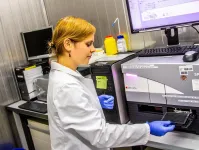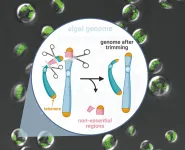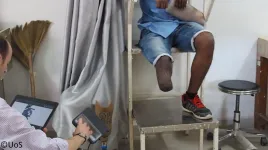(Press-News.org) An international team of scientists from the University of Turku, Finland and PennState University, USA have solved a long-standing mystery of how living organisms distinguish RNA and DNA building blocks during gene expression paving the way for the design of new antiviral drugs. The new insights were published in the journal Nature Communications.
All cellular organisms use two types of nucleic acids, RNA and DNA to store, propagate and utilize their genetic information. The synthesis of DNA is carried out by enzymes called DNA polymerases and is needed to accurately transfer the genetic information from generation to generation. Synthesis of RNA is carried out by enzymes called RNA polymerases and is needed to utilize the genetic information to ultimately produce proteins that in turn fulfil most structural and catalytic functions in all modern-day living organisms.
The ancient problem faced by RNA and DNA polymerases is that the DNA and RNA building blocks are very hard to distinguish. Those building blocks are identical except for a small part of the molecule, called the 2'OH group that is present in the RNA building blocks but is absent from the DNA building blocks.
DNA polymerases avoid using the RNA building blocks by featuring a cavity called the active site that is just big enough to bind the DNA building blocks but is too small to accommodate the slightly bigger RNA building blocks. As a result, only DNA building blocks bind to the active site cavity and get attached to the growing DNA polymer.
- RNA polymerases cannot use the same strategy because the smaller DNA building blocks will always fit into the same active site cavity as the RNA building blocks, explains Senior Researcher Georgi Belogurov.
RNA Polymerase Active Site Cavity Deforms the DNA Building Blocks
To understand how RNA polymerases avoid using DNA building blocks, a research team from the University of Turku headed by Belogurov performed complex biochemical measurements using RNA polymerases that were altered by carefully engineered mutations. At the same time, the research team at Penn State University, USA, led by Professor Katsuhiko Murakami obtained a detailed three-dimensional structure of RNA polymerase with the DNA building block.
By the combined analysis of the biochemical and structural data Doctoral Candidate Janne Mäkinen, the first author of the study, and his colleagues discovered that RNA polymerase evolved the active site cavity that deforms the DNA building blocks so that they are no longer suitable for incorporation into the RNA chain.
- The deformed DNA building blocks then dissociate from the RNA polymerase instead of being attached to the growing RNA polymer, says Mäkinen.
Human and Viral RNA Polymerases Select RNA Building Blocks Differently - Finding Enables Development of More Effective Antiviral Drugs
The study was financially supported by the Academy of Finland, Sigrid Juselius Foundation (Finland), and the National Institute of Health (USA) and has long-reaching implications for translational research.
- RNA viruses such as SARS-Cov-2 that is the causative agent of COVID-19 disease also synthesise RNA as a part of their infectious cycle. Viruses use their own RNA polymerases that are very different from RNA polymerases of the human cell but also need to select the RNA building blocks and reject the DNA building blocks, says Georgi Belogurov.
By careful comparison of the newly discovered selectivity mechanism with the findings of other research teams, Mäkinen and colleagues concluded that viral and human RNA polymerases use different mechanisms to reject the DNA building blocks. They suggest it may be possible to design a synthetic molecule similar to a DNA building block that would selectively bind and inhibit viral RNA polymerase but will be rejected by the human RNA polymerases and therefore will not interfere with the synthesis of RNAs needed by the human cell.
- This paves the way for the designing of potent and selective antiviral drugs targeting viral RNA polymerases, says Belogurov.
INFORMATION:
The article "The mechanism of the nucleo-sugar selection by multi-subunit RNA polymerases" was published in the journal Nature Communications.
Our immune system is very successful when it comes to warding off viruses and bacteria. It also recognizes cancer cells as potential enemies and fights them. However, cancer cells have developed strategies to evade surveillance by the immune system and to prevent immune response.
In recent years, fighting cancer with the help of the immune system has entered into clinical practice and gained increasing importance as a therapeutical approach. Current therapies apply so-called immune checkpoint inhibitors. Immune checkpoints are located on the surface ...
A single-celled alga undergoes genome surgery to remove non-essential parts. This can lead to a most efficient cellular factory for producing sustainable biofuels from sunlight and carbon dioxide.
Researchers from the Qingdao Institute of BioEnergy and Bioprocess Technology (QIBEBT) of the Chinese Academy of Sciences (CAS) have stripped hundred-kilobase genome from a type of oil-producing microalgae, knocking out genes non-essential for it to function. By doing so, they have created a "genome scalpel" that can trim microalgal genomes rapidly and creatively.
The 'minimal genome' microalgae produced is potentially useful as a model organism for further study of the molecular and biological function of every gene, or as a 'chassis' strain for synthetic biologists to augment for customized ...
RALEIGH, N.C. -- Methane hydrate, an ice-like material made of compressed natural gas, burns when lit and can be found in some regions of the seafloor and in Arctic permafrost.
Thought to be the world's largest source of natural gas, methane hydrate is a potential fuel source, and if it "melts" and methane gas is released into the atmosphere, it is a potent greenhouse gas. For these reasons, knowing where methane hydrate might be located, and how much is likely there, is important.
A team of researchers from Sandia National Laboratories and the U.S. Naval Research Laboratory have developed a new system to model the likelihood of finding methane ...
Cutting-edge 3D scanners have been put to the test by researchers from the University of Southampton and partners Exceed Worldwide to help increase the quality and quantity of prosthetics services around the world.
The study, carried out within the END ...
A team of scientists led by Dietmar Krautwurst from the Leibniz Institute for Food Systems Biology at the Technical University of Munich has now identified address codes in odorant receptor proteins for the first time. Similar to zip codes, the codes ensure that the sensor proteins are targeted from inside the cell to the cell surface, where they begin their work as odorant detectors. The new findings could contribute to the development of novel test systems with which the odorant profiles of foods can be analyzed in a high-throughput process and thus could be better controlled.
The ...
Alchemy, which attempted to turn cheap metals such as lead and copper into gold, has not yet succeeded. However, with the development of alloys in which two or three auxiliary elements are mixed with the best elements of the times, modern alchemy can produce high-tech metal materials with high strength, such as high entropy alloys. Now, together with artificial intelligence, the era of predicting the crystal structure of high-tech materials has arrived without requiring repetitive experiments.
A joint research team of Professor Ji Hoon Shim and Dr. Taewon Jin (first author, currently at KAIST) of POSTECH's Department of Chemistry, and Professor Jaesik Park of POSTECH Graduate School of Artificial Intelligence have together developed a system that predicts ...
TROY, N.Y. -- Numeric anchoring is a long-established technique of marketing communication. Once a price is mentioned, that number serves as the basis for -- or "anchors" -- all future discussions and decisions. But new research shows that this phenomenon is not limited to decisions that involve numbers, the use and understanding of which require high-level cognitive thinking. Anchoring also biases judgments at relatively low levels of cognition when no numbers are involved.
In research recently published in the Journal of Behavioral Decision Making, Gaurav Jain, an assistant professor in the Lally School of Management at Rensselaer Polytechnic Institute, demonstrated that anchoring even occurs in perceptual domains, ...
Chemists all over the world are constantly searching for simple ways to make elemental nitrogen or N2 in the air available for chemical reactions. This is no easy task, as nitrogen is a particularly non-reactive gas with a triple bond, which is one of the strongest known chemical bonds. A research team at Friedrich-Alexander-Universität Erlangen-Nürnberg (FAU) has now demonstrated that calcium, a metal commonly found in nature, is able to break the highly-stable nitrogen bond and can do so at minus 60°C. This is significant for two reasons. On the one hand, the researchers at FAU have made a new discovery in terms of the bond-breaking capabilities of calcium, which had been largely disregarded in the past. On ...
The snow may be melting, but it is leaving pollution behind in the form of micro- and nano-plastics according to a McGill study that was recently published in Environmental Pollution. The pollution is largely due to the relatively soluble plastics found in antifreeze products (polyethylene glycols) that can become airborne and picked up by the snow.
The researchers used a new technique that they have developed to analyze snow samples collected in April 2019 in Montreal for both micro- and nano-sized particles of various plastics. The McGill technique is orders of magnitude more sensitive than any of the other current methods used for tracing plastic in the environment. It ...
Researchers at Rutgers School of Dental Medicine have found evidence that two types of mouthwash disrupt the COVID-19 virus under laboratory conditions, preventing it from replicating in a human cell.
The study, published in the journal Pathogens, found that Listerine and the prescription mouthwash Chlorhexidine disrupted the virus within seconds after being diluted to concentrations that would mimic actual use. Further studies are needed to test real-life efficacy in humans.
The study was conducted in a lab using concentrations of the mouthwash ...





